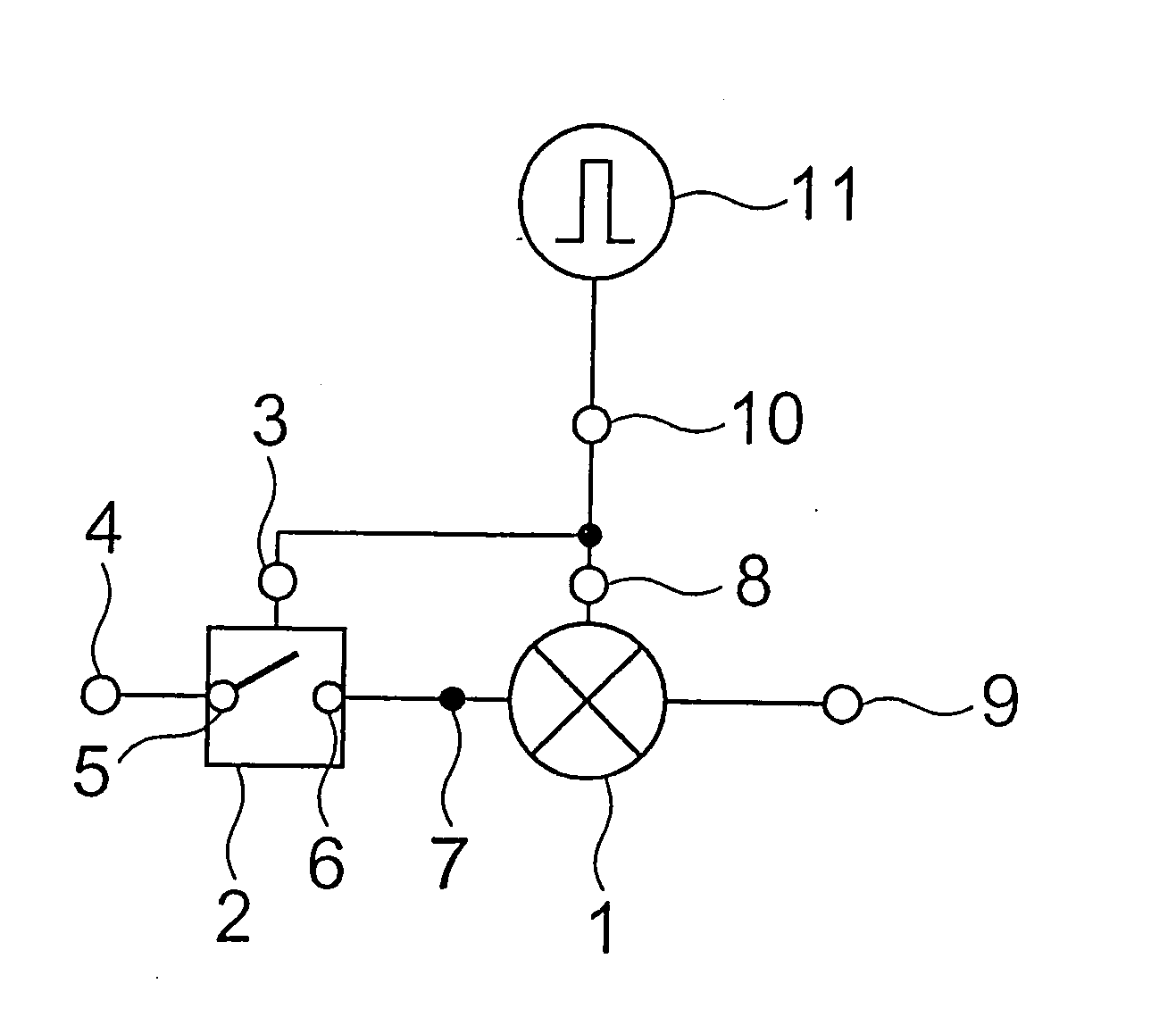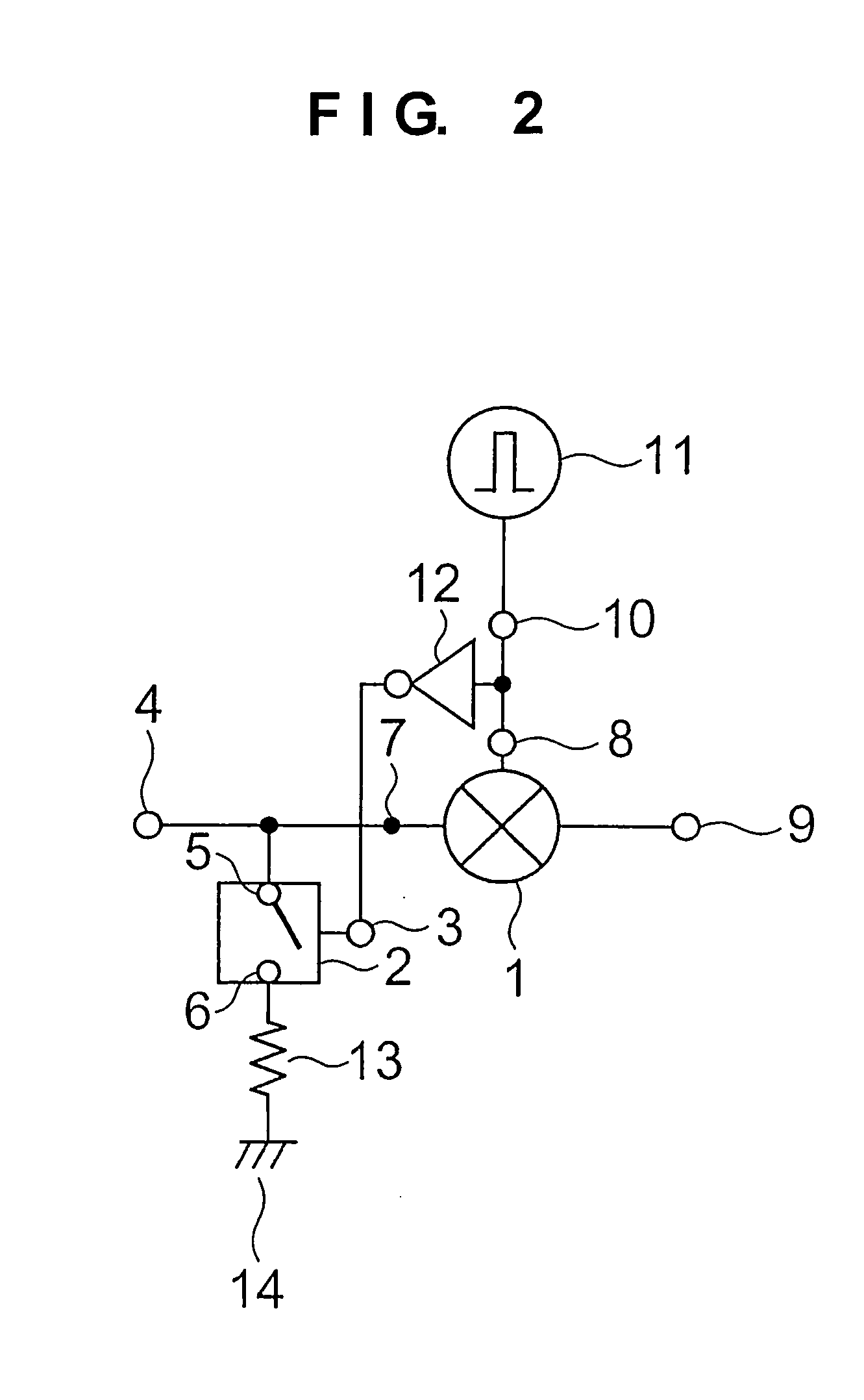Pulse modulation circuit
- Summary
- Abstract
- Description
- Claims
- Application Information
AI Technical Summary
Benefits of technology
Problems solved by technology
Method used
Image
Examples
first embodiment
[0022]FIG. 1 shows the structure of a pulse modulation circuit in accordance with a first embodiment of the present invention. The pulse modulation circuit according to the present invention is a pulse modulation circuit using a harmonic mixer 1 that inputs an LO signal (local oscillation wave) and a DC pulse, mixes the second harmonic wave of the LO signal with the DC pulse, and outputs an RF pulse signal. The harmonic mixer 1 inputs the LO signal to a harmonic mixer LO signal input terminal 7, inputs a DC pulse signal to a harmonic mixer IF signal input terminal 8, mixes those inputted signals together, and outputs a sum frequency component of the second harmonic wave of the LO signal and the DC pulse signal to an RF signal output terminal 9. It is assumed that the frequency of the LO signal is fLO, the frequency of the DC pulse signal is fIF, and the frequency of the RF signal is fRF, a relation of fRF=2fLO+fIF is established.
[0023] As shown in FIG. 1, the pulse modulation circu...
second embodiment
[0027]FIG. 2 shows the structure of a pulse modulation circuit in accordance with a second embodiment of the present invention. As shown in FIG. 2, the pulse modulation circuit according to this embodiment includes a harmonic mixer 1, a single pole single throw (SPST) switch 2, and a pulse signal generator 11, as in the structure shown in FIG. 1. In this embodiment, the SPST switch 2 is connected in parallel with the fore stage of the harmonic mixer 1. That is, an LO signal input terminal 4 for applying the LO signal is connected to an SPST switch input terminal 5 that is disposed in the SPST switch 2, and an SPST switch output terminal 6 that is disposed in the SPST switch 2 is grounded to a grounding point 14 through a terminating resistor 13. Also, a harmonic mixer LO signal input terminal 7 is disposed between the SPST switch 2 and the harmonic mixer 1. A pulse signal supply terminal 10 that is connected to a pulse signal generator 11 is connected to the SPST switch 2 through an...
third embodiment
[0031]FIG. 3 shows the structure of a pulse modulation circuit in accordance with a third embodiment of the present invention. As shown in FIG. 3, the pulse modulation circuit according to this embodiment includes a harmonic mixer 1, a single pole double throw (SPDT) switch A15, an SPDT switch B16, a band rejection filter 17 (hereinafter referred to as BRF 17″), and a pulse signal generator 11. In this embodiment, the SPDT switch A15, the SPDT switch B16, and the BRF17 constitute a switching circuit (switch) . The switching circuit is connected in series to the fore stage of the harmonic mixer 1, and the LO signal is inputted to the harmonic mixer 1 through the switching circuit. That is, an LO signal input terminal 4 for supplying the LO signal is connected to an input terminal 30 that is disposed in the SPDT switch A15, and an output terminal 31 that is disposed in the SPDT switch B16 is connected to the harmonic mixer 1 through the harmonic mixer LO signal input terminal 7. In ad...
PUM
 Login to View More
Login to View More Abstract
Description
Claims
Application Information
 Login to View More
Login to View More - R&D
- Intellectual Property
- Life Sciences
- Materials
- Tech Scout
- Unparalleled Data Quality
- Higher Quality Content
- 60% Fewer Hallucinations
Browse by: Latest US Patents, China's latest patents, Technical Efficacy Thesaurus, Application Domain, Technology Topic, Popular Technical Reports.
© 2025 PatSnap. All rights reserved.Legal|Privacy policy|Modern Slavery Act Transparency Statement|Sitemap|About US| Contact US: help@patsnap.com



